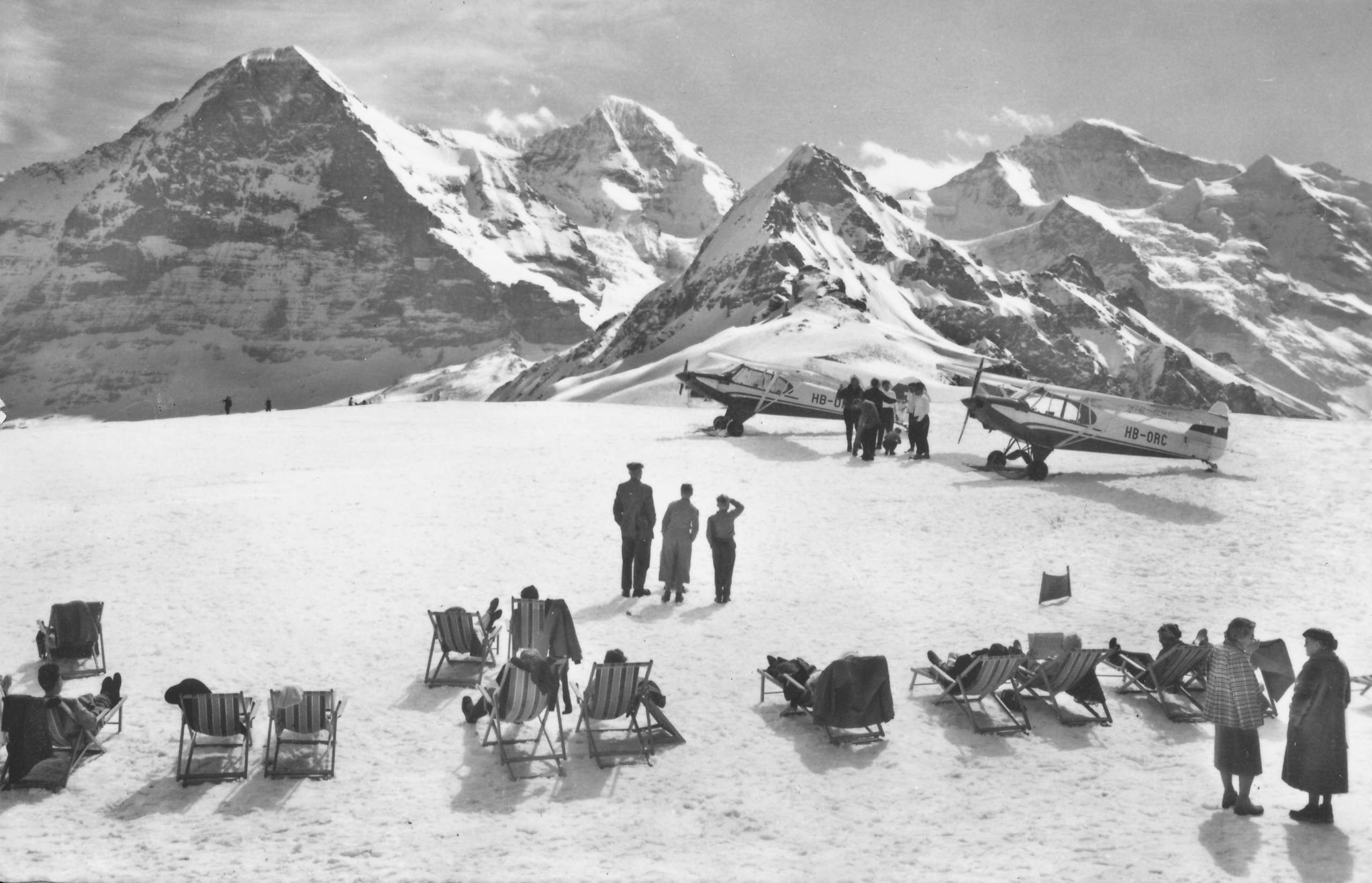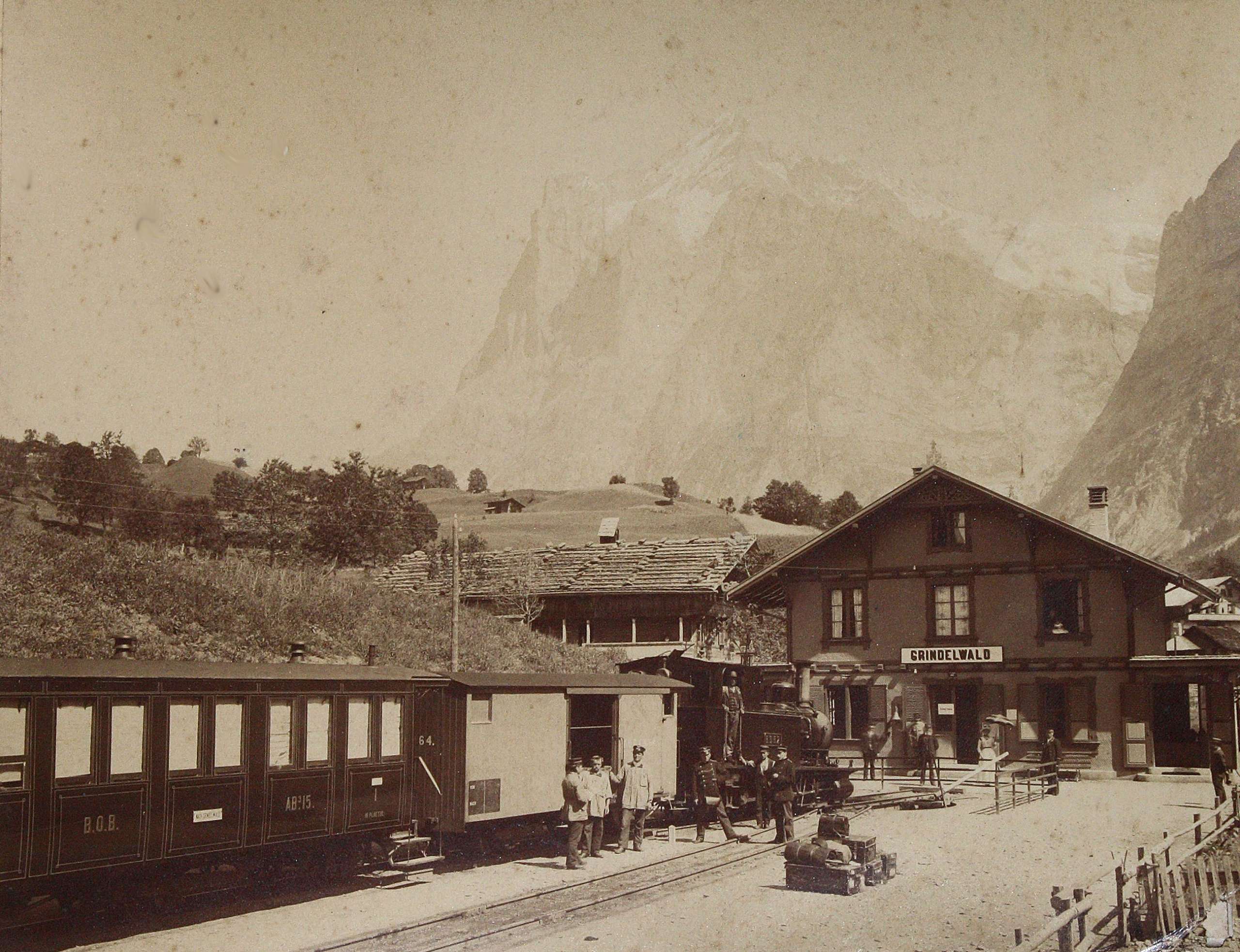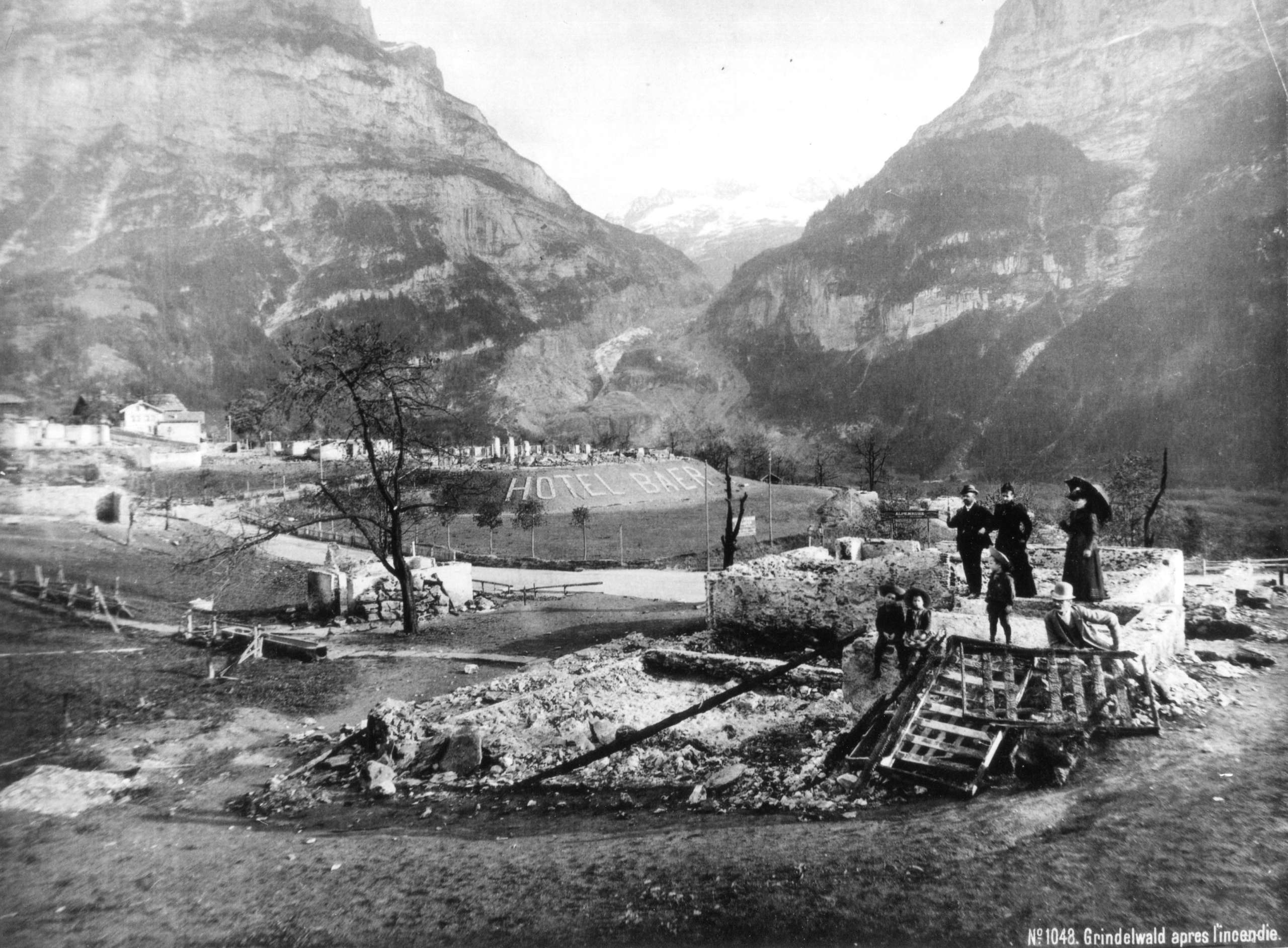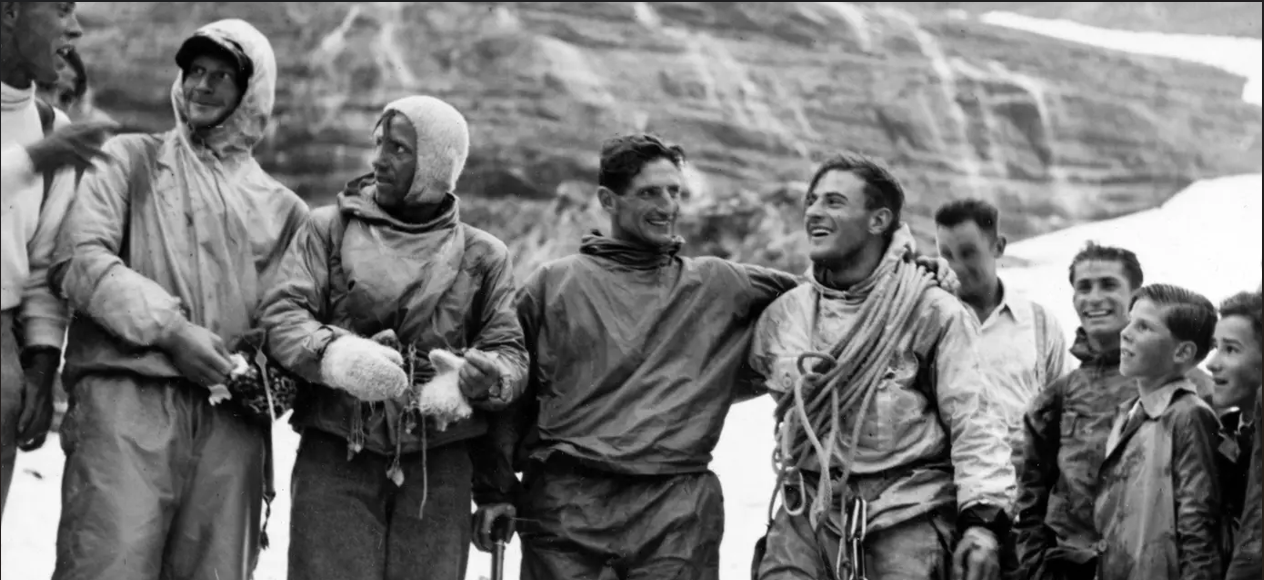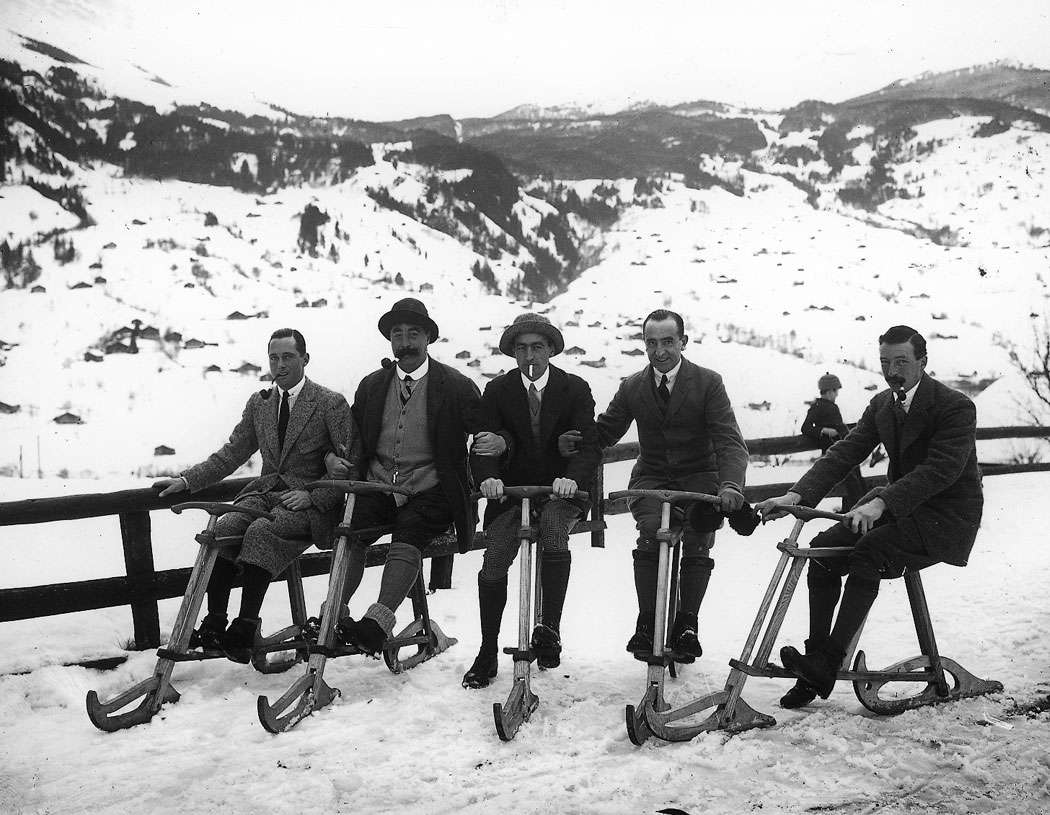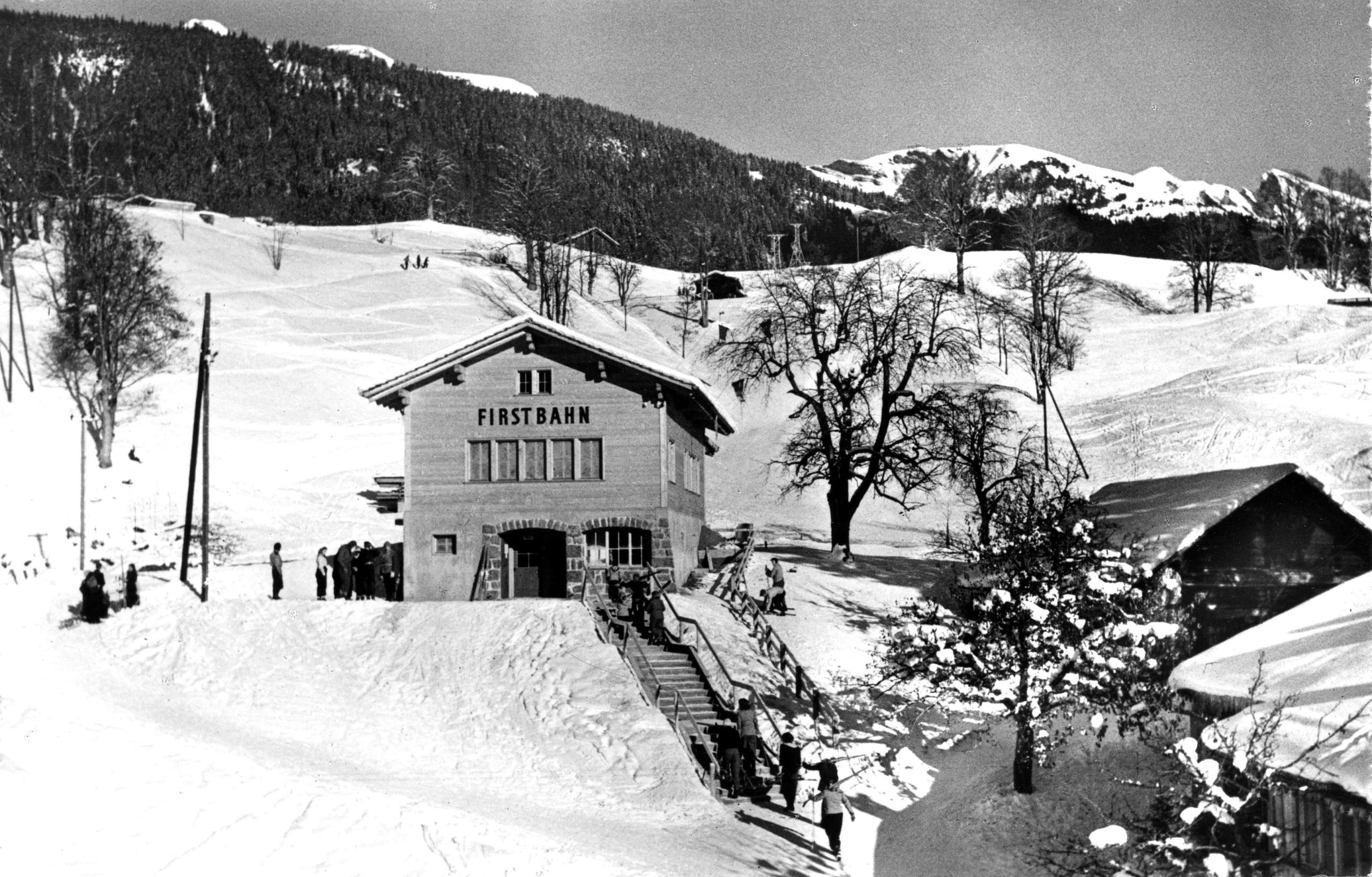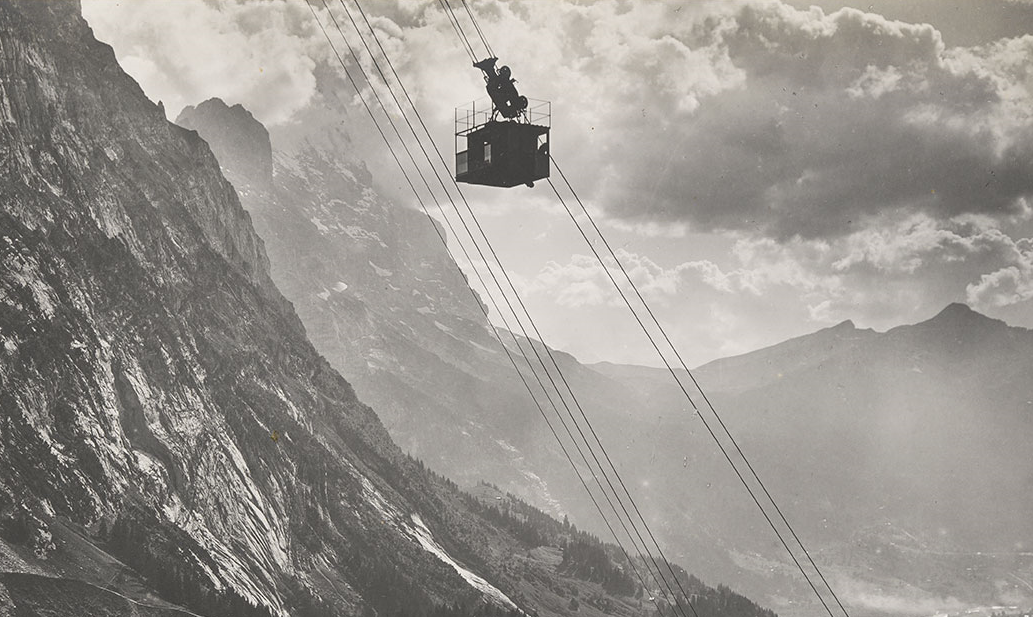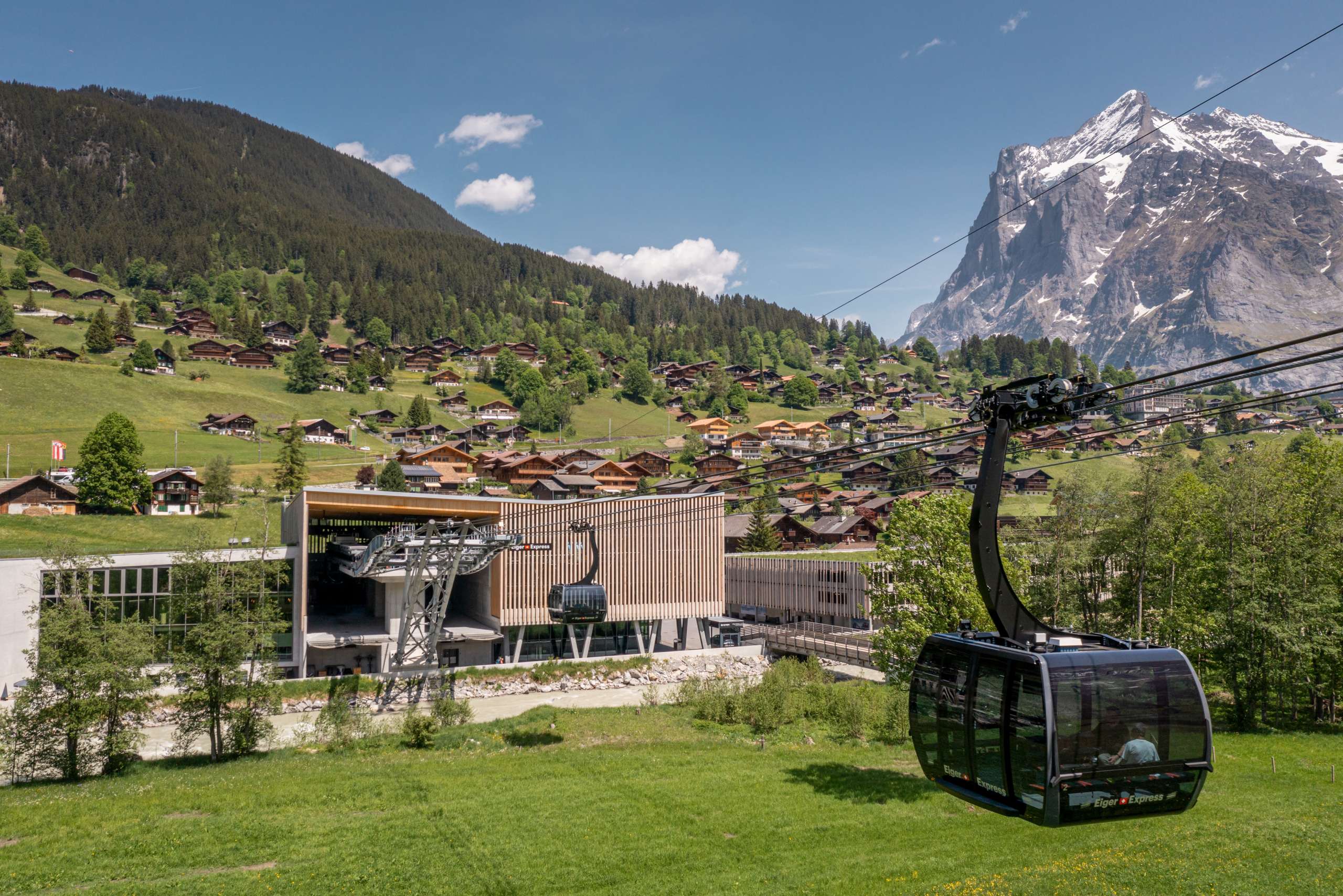First tourist development
Thanks to its impressive panorama and tangible glaciers, the area had already attracted Alpine enthusiasts, especially English visitors, from the late 18th century onwards. The real breakthrough of alpinism occurred in the mid-19th century; local mountain guides climbed peaks together with English mountaineers, including the Finsteraarhorn (1812), the Wetterhorn (1854), the Eiger (1858), the Schreckhorn, and the Fiescherhorn (1862). Initially, travelers were accommodated in the parsonage or private homes.
Tourism in Grindelwald began to develop in the 18th century, with the first hotel, the Schwarzer Adler, opening in 1820, and the first road following in 1860. As the first spa town in the Bernese Oberland, Grindelwald also opened to winter tourism in 1888. Attractions included sleigh rides, curling, ice skating, and skiing, later followed by bobsledding and ice hockey. In 1890, the Bernese Oberland Railway began operations. The hotel industry grew from 10 hotels in 1889 to 33 by 1914. The first cog railway (Wengernalp Railway) to Kleine Scheidegg opened in 1893 and was extended to the Jungfraujoch in 1912; numerous SAC huts were built for mountain tourists. After a prolonged crisis caused by the wars and the global economic depression, tourism recovered strongly after 1945.
A pronounced para-hotel sector also emerged, including chalets, home stays, group tourism, and campsites. A vast hiking and skiing area was developed with chairlifts (First 1947, Männlichen 1978), ski lifts, bus lines, and mountain restaurants. Today, over 90% of Grindelwald’s economy depends on tourism.
The Great Fire of Grindelwald
First Ascent of the Eiger North Face
The Eiger is one of the most historically significant mountains in the Alps—its North Face became famous above all for dramatic ascents and climbing exploits. The face rises over 1,800 meters, and the summit of the mountain reaches 3,967 meters above sea level. During the first two attempts to climb it in 1935 and 1936, all the mountaineers died.
At that time, the Eiger North Face also earned the nickname the "Murder Wall." In 1938, the German/Austrian four-man team of Heinrich Harrer († 2006), Fritz Kasparek († 1954), Andreas Heckmair († 2005), and Ludwig Vörg († 1941) completed the first ascent, which took more than three days. Today, there are over 30 interconnected routes through the face, all requiring mastery of excellent climbing skills.
Nowadays, top alpinists can climb the North Face within a few hours under favorable weather conditions. Since November 2015, the free solo record on the Heckmair Route stands at 2 hours, 22 minutes, and 50 seconds (as of 2024), still held by Swiss extreme mountaineer Ueli Steck († 2017).
Construction of the Jungfrau Railway
The construction of the Jungfrau Railway represents a pioneering achievement in the development of the Alps. Step by step, the workers made their way through the Eiger and Mönch to reach the Jungfraujoch. In August 1893, the Swiss entrepreneur Adolf Guyer-Zeller decided during a hike to build a railway from the Kleine Scheidegg to the Jungfrau. In December 1894, Guyer-Zeller received the construction concession, and construction began in July 1896. After just over two years, the first section opened in September 1898. Guyer-Zeller organized a splendid inauguration ceremony, attracting new shareholders who guaranteed the continuation of the project.
Despite numerous challenges, the breakthrough was achieved in February 1912: the Jungfraujoch was reached. Only five months later, 16 years after construction began, the first festively decorated train carrying invited guests traveled the 9.3-kilometer route. On the Jungfrau plateau, the company celebrated this magnificent achievement against a grand backdrop and with an equally impressive view. Jungfraujoch—Top of Europe, the pinnacle of all high-altitude journeys and the highest railway station in Europe—was born.
Velogemel
A hundred years ago, it was not easy for the residents of Grindelwald to get around in deep snow. Roads and paths were not cleared. For the mobility-impaired Christian Bühlmann, walking from the village to his home was too exhausting. While he could use a bicycle in the summer, he wondered how he could apply the same principle to a sled. In 1911, he built a snow bicycle that would allow him to reach his destination more quickly on flat and downhill routes—the Veloschlitten. A wooden frame with two runners, steerable at the front by a handlebar, allowed him to move forward while seated using leg movements and pushing off with his shoes. He used ash wood for the frame and maple for the runner supports, handlebar, and seat. Two blacksmiths in Grindelwald manufactured the runners.
Later that same year, Bühlmann traveled to Bern and had his “single-track steerable sport sled” patented.
Inspired by the Grindelwald dialect word “Gemel” for sled, the locals soon began calling the Veloschlitten the Velogemel. The Velogemel is an exclusive Grindelwald vehicle. Since 1996, a world championship in Velogemel racing has been held annually in Grindelwald.
The Seven Mountain Communities
Grindelwald is divided into seven districts, known as the “Bergschaften.” Today, these Bergschaften exist under law as public-law corporations.
Starting in Burglauenen, they are: Bussalp, Holzmatten, Bach, Grindel, and Scheidegg (sunny side). On the shady side, there are Wärgistal and Itramen.
Each Bergschaft has an alp of the same name, which is managed cooperatively. The structure of these cooperatives is more than half a millennium old (valley charter from 1404/1538, latest version from 2002) and has proven effective.
For each alpine right, a fence must be built on the alp, which is reallocated by lottery every 20 years. These fences separate private land (Vorsassen) from the alp, divide the pastures, and prevent grazing on hazardous terrain.
The alpine area covers around 60 km² of the municipality’s total 171 km². Including the unproductive mountain regions, the alpine area accounts for about two-thirds of the usable land. The alpine huts are mostly privately owned and not recorded in the land register, but the land itself belongs to the Bergschaft. They cannot be repurposed, and the respective Bergschaft always retains the right of first refusal. Even today, the alpine regulations largely follow the valley charter.
The History of the First Cable Car
The history of the Firstbahn in Grindelwald dates back to the 1930s. Originally, a funicular railway was planned, but this idea was halted by the outbreak of World War II and Switzerland’s general mobilization. During the war, the Ludwig von Roll Ironworks Company developed a new system for mountain railways, which later became the basis for the chairlift.
After the war, construction of the chairlift began. The concession was granted in September 1946, and work progressed rapidly. In December 1946, the first two sections—Grindelwald–Oberhaus and Oberhaus–Bort—were completed. The remaining sections, Bort–Egg and Egg–First, followed in early 1947. The official inauguration took place in June 1947.
As a pioneering project, the first chairlift faced various technical challenges, including wear and terrain slippage, which were overcome through innovative solutions such as movable steel towers. In the 1980s, a comprehensive development plan was created, ultimately leading to the modernization of the installation. Construction of the new six-person gondola began in June 1990, and by November 1991, the modern gondola lift was in operation.
The present-day Firstbahn (as of 2024), consisting of six-person gondolas and capable of transporting up to 1,200 people per hour, connects Grindelwald with Bort, Schreckfeld, and First. It has become an important part of tourism in the region and offers numerous year-round attractions such as the First Cliff Walk, First View, the First Flyer, the First Glider, as well as mountain carts and trottibikes in summer.
The Wetterhorn Lift
The Wetterhorn Lift near Grindelwald was opened in July 1908 and was the first public aerial cableway for passenger transport in Switzerland. With a gradient of 116 percent, the line was more of an elevator than a cableway—hence the name “Wetterhorn Lift.” The municipality of Grindelwald saw in it an excellent tourist attraction and supported the German engineer Wilhelm Feldmann financially, also providing the necessary land. The route ran over what was then the tongue of the now-retreated Upper Grindelwald Glacier. The approximately eight-minute ride cost five Swiss francs—a small fortune at the time.
Today, below the trail to the Gleckstein Hut, the ruins of the upper station “Enge” can still be seen, and a replica of the cabin is displayed near the Hotel Wetterhorn (as of 2024). Originally, there were plans to extend the cableway in three additional sections all the way to the summit of the Wetterhorn, which stands at 3,692 meters above sea level. However, the outbreak of World War I in 1914 brought an end to the Wetterhorn Lift.
The lack of tourists ultimately sealed the fate of Switzerland’s first aerial cableway. The concession, which had been issued for 20 years, was never renewed. When a rockslide destroyed the lower station, the chapter of the Wetterhorn Lift finally came to a close.
Marble Quarry and Ice Export
Marble Quarry
Around 1730, Grindelwald marble was discovered in the frontal region of the Lower Grindelwald Glacier and was quarried between 1740 and 1760. Afterwards, the advancing glacier once again covered the deposit. The marble extracted in the 18th century was used for furniture panels and fireplace surrounds. After a break of over a hundred years, the glacier exposed the deposit again, allowing quarrying to resume from 1867 to 1903. After that, only isolated blocks were removed from the quarry. Some representative pieces from the final extraction phase were used for the interior decoration of the Swiss Parliament building; otherwise, marble production in Grindelwald did not flourish, mainly due to the high extraction costs.
Ice Export
Around 1850, the Lower Grindelwald Glacier extended about 500 meters toward Grindelwald Grund from the present entrance of the glacier gorge. It was the only Alpine glacier reaching below 1,000 meters above sea level. In 1863, the Bernese company Schegg & Böhlen received a concession for commercial ice harvesting. A road was then built from Grindelwald Grund to the glacier tongue. Ice blocks were transported to Interlaken via the Bödelibahn and exported as a cooling medium as far as Paris. In 1864, for example, 17,473 hundredweight of ice were harvested. With the advent of refrigeration technology and the outbreak of World War I, the extraction and export of glacier ice ended in 1914.
Construction of the V-Bahn
With the full opening of the V-Bahn in December 2020, the Jungfrau Railways entered a new era. Over the course of eight years, two cable cars, a new connection to public transport, a parking garage, a terminal serving as the valley station, and a modern mountain station connected to the historic Jungfrau Railway—built between 1896 and 1912—were constructed. The realization of these projects was achieved through great perseverance, determination, and patience.
In December 2019, the new Männlichenbahn, the first part of the terminal, and the new BOB station were already operational. Meanwhile, construction continued at Grindelwald Grund and the Eigergletscher. Since December 2020, the world’s heaviest and most modern 3S cable car, the Eiger Express, has been transporting guests from Grindelwald Terminal to the new Eigergletscher station in just 15 minutes. The impressive ride in cabins with 26 seats passes by the world-famous Eiger North Face. At the new Eigergletscher mountain station, guests can transfer directly to the Jungfrau Railway toward the Jungfraujoch.
The V-Bahn ensures the medium- and long-term success of tourism in the entire Jungfrau Region as an attractive year-round destination in Swiss tourism.


